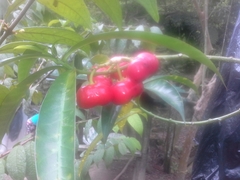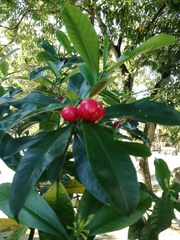
Neotropical Flora
|
Family: Apocynaceae
[Ahouai nitida (Kunth) Pichon, moreCerbera nitida Kunth, Thevetia nitida (Kunth) A. DC.] |
Shrub or small tree, usually to 6 m or less tall, +/- glabrous; sap milky, copious. Leaves alternate; petioles very short or to ca 1 cm long, glandular in axils; blades usually oblanceolate, acute to acuminate, tapered to an acute base, 14-25 (30) cm long, 5-7 (8) cm wide, bicolorous, drying blackened. Cymes mostly terminal, irregular; pedicels to 3 cm long; flowers 5-parted; calyx lobes ovate, 5-7 mm long, spreading, with numerous slender squamellae inside at base; corolla cream, pale yellow or white, the tube 2.5-4 cm long, densely pubescent near stamens, closed near apex by 5 triangular appendages held opposite and just above stamens, the lobes spreading, twisted, to 2.5 cm long, rounded at apex; stamens included, attached near apex of tube; anthers ca 1.8 mm long, free; style with an expanded apex, the lower margin revolute; stigmas 2, thick. Fruits bright red, fleshy, broader than long, ca 3 cm long, 5 cm wide, and 3.5 cm thick; seeds 2-4, +/- ovoid, rounded on one side, depressed on the other with a markedly raised margin. Croat 5032, 8359. Frequent in the forest, especially the younger forest. The flowers and mature fruits have been seen throughout the year. Southern Mexico to northern South America. In Panama, known from tropical moist forest in all regions, from tropical dry forest in Panama (Taboga Island), from premontane moist forest in the Canal Zone and Panama, from premontane wet forest in the Canal Zone, Panama, and Darién, and from tropical wet forest in Colón. See Fig. 465. |
|
|
|
Powered by Symbiota.



























































